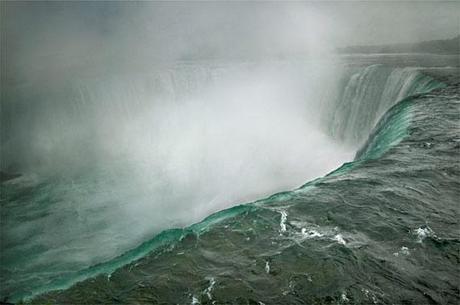
Annie Leibovitz, Niagara Falls, Ontario, Canada, 2009, © Annie Leibovitz. From Pilgrimage (Random House, 2011)
Pilgrimage is a personal journey by photographer Annie Leibovitz, celebrated over the decades for her astute portraits of the cultural landscape. In Pilgrimage, the landscape is real: out of the photographer's studio and into icons of America, from the homes or workplaces of Elvis Presley to Ralph Waldo Emerson to Georgia O'Keeffe, from Niagara Falls to Yosemite Valley to Emily Dickinson's home in Amherst, to the work of photographers Alexander Gardner and Ansel Adams, to name a few. The photos at first appear quieter than her renowned commercial work, and glow with a light that seems to have been turned on within. Pilgrimage runs at American Art from January 20 through May 20, 2012.
Eye Level: Tell me how Pilgrimage came about.
Annie Leibovitz: It started off with a list of twelve or so places, people, and ideas and it became a book of twenty-seven, and it continues. Everything on the list made it into the book. One of the key places was the Lincoln Memorial. I grew up in the D.C. area and attended high school here. I honestly don't know why I put it on the list, but it became a touchstone.
EL: Speaking of Lincoln, having the exhibition at the Smithsonian American Art Museum in the building where the president had his second inaugural seems appropriate to the emotional tone and content of the book.
AL: It's so exciting to be doing this at the Smithsonian. When I was at the Presidential Library in Springfield, Illinois, I bought a copy of Lincoln's writings that the Library of Congress had published and I just fell in love. We all knew the Gettysburg Address as kids, but did not take in the eloquence of the writer, and how beautiful his prose was. We flew down to Kentucky in search of his log cabin, and headed toward Hodgenville, a little town about 50 miles outside of Louisville. We found his birthplace, Sinking Spring Farm, then Knob Creek Farm, where Lincoln lived from about age two through eight. It was about ten miles between the two sites. [It was wonderful] just to be out in the country and [experience] The Lincoln Heritage trail. It's a great country; let's face it.
EL: Lincoln was no stranger to having his photo taken.
AL: Lincoln himself is quite interesting. He and his son Tad would cross the street from the White House to get his picture taken. He was the most photographed president at the time. If you think about the technical limits of the time, you never got his whimsical side because he would have had to sit for four minutes with a smile. Lincoln's secretary, John Nicolay wrote, "Lincoln's features were the despair of every artist who undertook his portrait." Apparently he was unbelievably charming.
EL: I love how one story brings you to another. For instance, Abraham Lincoln brings you to Gettysburg (and photographers Mathew Brady and Alexander Gardner) to the Lincoln Memorial to Daniel Chester French to Marian Anderson...
AL: You can't help it. I became obsessed with Gettysburg and tried to understand it by following in Alexander Gardner's footsteps through the southern battlefield. William Frassanito's book, Gettysburg: A Journey in Time, is really the bible on Gettysburg. He spent a great deal of time there, and discovered that all of Gardner's photos were taken in one spot, though they [had been described as] representing the whole battlefield. Gardner would drive his wagons in, park them at, say, Rose Farm or Devil's Den. And the horrifying thing Frassanito discovered is that the famous "Rebel Sharpshooter" had been dragged forty yards and propped up. So I was literally walking around with Frassanito's book. I was hooked. In fact, last year I cleared the room at Thanksgiving by talking about Gettysburg for three hours. "Enough, enough" people said and walked out. But it's a subject you can get so involved in.
EL: Having this book in my hand is an intimate experience but how will that translate to the exhibition?
AL: It always was a modest project, which is why the rooms here are almost perfect. I wanted to keep it as a learning experience because it was a learning experience for me. You get to go on the road trip with me. The prints are modest [in size], not that large. There are just two sizes: a little smaller and a little larger. The material was always a notebook, a gathering of notes. It served me and filled me up with inspiration to refill my heart and soul. That was the first thing I accomplished on some level. And it's all out there for us. Our history is there. You don't have to make an appointment to go to Walden Pond. You can go to Yosemite to see what Ansel Adams saw. Everyone should sit down and make their own lists. I want everyone to go out and make their own lists and fill themselves up. That's my great hope. This is my list and it doesn't end...
Annie Leibovitz's exhibition, Pilgrimage, will be at the Smithsonian American Art Museum from January 20 through May 20, 2012. Her artist talk on January 24 is sold out, but you can watch the webcast here.

